#1824-1889
Video
n136_w1150 by Biodiversity Heritage Library
Via Flickr:
Reichenbachia :. St. Albans [England] :N.Y. [i.e. New York] :F. Sander ;R.B. Young,1892-1894.. biodiversitylibrary.org/page/35543585
#(Heinrich Gustav)#1824-1889#Orchidaceae#Reichenbach#H. G#Missouri Botanical Garden#Peter H. Raven Library#bhl:page=35543585#dc:identifier=http://biodiversitylibrary.org/page/35543585#taxonomy:binomial=Dendrobium phalaenopsis#taxonomy:binomial=Dendrobium bigibbum#Henry Frederick Conrad Sander#orchids#botany#flowers#artist:name=Henry George Moon#artist:viaf=95737474#flickr#Phalaenopsis#dendrobium phalaenopsis#cooktown orchid#Dendrobium bigibbum#mauve butterfly orchid
4 notes
·
View notes
Text

La tour Eiffel, la nuit, by Alexey Petrovich Bogolyubov (Russian, 1824-1896), 1889
#dark academia#light academia#classical#academia aesthetic#escapism#academia#books and libraries#classic literature#books#architecture#art#artist#painting#painter#la tour Eiffel#eiffel tower#1800s#19th century#Alexey Petrovich Bogolyubov#russian#royal core#cottage core#aesthetic#mood#vibe#tumblr
773 notes
·
View notes
Text

Heinrich Hofmann (German, 1824-1911)
Christ at 33, 1889
Full painting called "Christ and the young rich ruler"
Riverside Church
Baptism of the dead is referred to by Saint Paul in 1 Corinthians 15:20. The text requires careful reading in the context of the whole of Chapter 15 concerning the resurrection of the dead. The Corinthians seem to have had a custom that if a catechumen (someone under instruction but not yet baptized) died without baptism, a member of the community would receive baptism in his name. This was not sacramental nor did it affect the dead person but simply celebrated his intention to be baptized and the saving effect of his grace-supported intention. (God saves all who sincerely wish to be saved.)
This custom was born of a belief in the resurrection. When Paul came to speak of the resurrection, therefore, and to calm the fears of those who were beginning to doubt it, one of his lesser arguments amounted to this: How can you express belief in the resurrection through baptizing the dead and at the same time not believe in it? All he is doing is pointing to an inconsistency in their thinking. He passes no judgement on their harmless custom.
As time went on, certain heretics like the Montanists taught that baptism of the dead was sacramental and effective in saving the dead. This was condemned by the Church as heretical.
Faith: Quest & Answers
Father John V. McGuire, C.Ss.R, General Editor: Father Juan-Diego Brunetta, O.P.
The Knights of Columbus Supreme Council
#knights of columbus#christian art#christian#Christianity#christentum#catholic#catholicism#catholic art#Jesus Christ#God the Son#The Son of God#Son of God#art#fine art#european art#classical art#europe#european#fine arts#oil painting#europa#mediterranean#Heinrich Hofmann#German#Germany#German art#1800s#christ and the young rich ruler#baptism of the dead#baptism for the dead
82 notes
·
View notes
Text
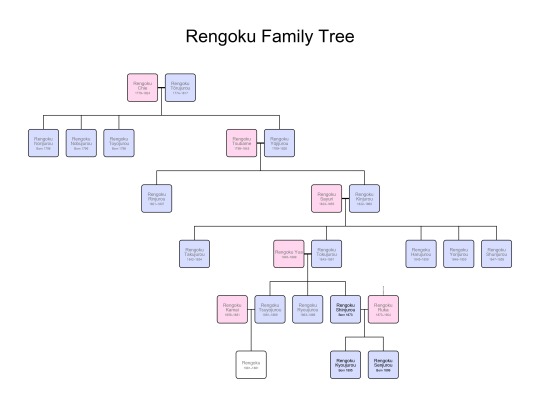
The Rengoku Family Tree from The Pendulum Keeps Swinging!
Rengoku Shinjurou - born 1873, married in 1891; current head of household; former Flame Hashira
Rengoku Ruka ( nee Kūran) - born 1873, married in 1891, died 1904; wife of Shinjurou and mother of 2 children
Rengoku Kyoujurou - born 1895; first son; current Flame Hashira
Rengoku Senjurou - born 1899; second son
Rengoku Tokujurou - born 1843, died 1891; former head of household; alcoholic; former Flame Hashira; second son of Kinjurou (see below)
Rengoku Yua - born 1845, died 1889; miko prior to marriage; wife of Tokujurou and mother of 3 children
Rengoku Tsuyojurou - born 1861, died 1899; first son of Tokujurou; former Flame Hashira; married to Kamai Akane (1859-1881) who passed away from maternal death along with their child
Rengoku Ryoujurou - born 1863, died 1889; second son of Tokujurou
Rengoku Kinjurou - born 1822, died 1860; former head of household; former Flame Hashira; second son of Yūjijurou (see below)
Rengoku Sayuri - born 1823, died 1855; was killed in the Edo earthquake of 1855; wife of Kinjurou and mother of 5 children
Rengoku Takujurou - born 1842, died 1854; presummed dead by 23 December 1854 Tōkai Tsunami; first son of Kinjurou
Rengoku Haurjurou - born 1845, died 1859; third son of Kinjurou
Rengoku Yorijurou - born 1846, died 1855; was killed in the Edo earthquake of 1855 with his mother; fourth son of Kinjurou
Rengoku Shunjurou - born 1847, died 1855; was plagued with illness and died due to it; fifth son of Kinjurou
Rengoku Yūjijurou - born 1799, died 1826; former head of household; former Hashira; former head of household; deaf in left ear and blind in right eye; third son of Tōrujurou (see below)
Rengoku Tsubame - born 1798, died 1845; wife of Yūjijurou and mother of 2 children; raised her children by herself after husband died from a Lower Moon Demon
Rengoku Rinjurou - born 1821, died 1837; was killed by the Tenpō famine; first son of Yūjijurou;
Rengoku Tōrujurou - born 1774, died 1817; former head of household; former Hashira; was gallantly killed in battle via a Demon who could change senses;
Rengoku Chie - born 1779, died 1824; wife of Tōrujurou and mother of 4 children
Rengoku Norijurou - born 1796, died 1819; married but no children; twin of Nobujurou; could never fully grasp all the forms of Flame Breathing, altering forms with twin
Rengoku Nobujurou - born 1796, died 1819; married but no children; twin of Norijurou; could never fully grasp all the forms of Flame Breathing, altering forms with twin
Rengoku Toyojurou - born 1798, died 1813; was killed in Final Selection
Direct Ancestor: Rengoku Hirojurou - the Demon Slayer who had helped out Yoriichi after his wife and unborn child died; would eventually become the first Flame Hashira
#demon slayer#rengoku kyoujurou#rengoku shinjuro#rengoku kyojuro#rengoku kyōjurō#rengoku senjurou#rengoku ruka#rengoku ryoujurou#rengoku tsuyojurou#rengoku tokujurou#rengoku senjuro#rengoku#rengoku family#rengoku family tree#kimetsu no yaiba#kny angst#kny oc#demon slayer oc#requiem of a redemption#the pendulum keeps swinging#kny fanfic#kny fanfiction#fanfiction#rengoku yua
92 notes
·
View notes
Text

William Holbrook Beard (American, 1824-1900), "Anthropomorphized Monkeys on the Beach,"
1889, oil on canvas
Clars
20 notes
·
View notes
Text

Anna Davidovna Abamelik-Lazareva (1824-1889) was a Russian-Armenian translator, lady-in-waiting, socialite and public figure. She was recognized as one of the most beautiful women of Russia of her times.
28 notes
·
View notes
Text
Knights of Liberty - Wikipedia
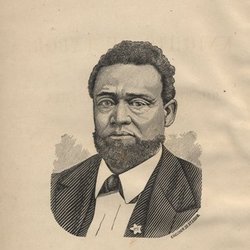
Pictured here is Moses Dickson, from the frontispiece illustration of the 1879 book A Manual of the Knights of Tabor and Daughters of the Tabernacle. In 1872, the Rev. Moses Dickson founded the International Order of Twelve of Knights and Daughters of Tabor, an African-American fraternal order focused on benevolence and financial programs. Dickson was born a free man in Cincinnati in 1824, was a Union soldier during the Civil War, and afterwards became a prominent clergyman in the African Methodist Episcopal Church. Dickson showed an interest in progressive fraternal organizations early on – in 1846 Dickson, with others, founded a society known as the Knights of Liberty, whose objective was to overthrow slavery; the group did not get beyond the organizing stages. Dickson was also involved in Freemasonry – he was the second Grand Master of the Prince Hall Grand Lodge of Missouri.
Dickson’s International Order of Twelve of Knights and Daughters of Tabor – or Order of Twelve, as it’s more commonly know – accepted men and women on equal terms. Men and women met together in higher level groups and in the governance of the organization, although at the local level they met separately – the men in “temples” and the women in “tabernacles” (akin to “lodges” in Freemasonry). The Order of Twelve was most prominent in the South and the lower Midwest. The major benefits to members – similar to many fraternal orders of the time – was a burial policy and weekly cash payments for the sick.
What many people today remember about the Order of Twelve is an institution founded in Mound Bayou, Misssissippi in 1942 – the Taborian Hospital. Michael Premo, a Story Corps facilitator, posted his appreciation for the impact that the Taborian Hospital had on the lives of African-Americans living in the Mississippi Delta from the 1940s-1960s. The Taborian Hospital was on the Mississippi Heritage Trust’s 10 Most Endangered List of 2000, and an update to that list indicates that the hospital still stands vacant and seeks funding for renovation. Here are some photos of the Taborian Hospital today.
Want to learn more about the Order of Twelve? Here are a few primary and secondary sources that we have here in our collection (with primary sources listed first):
Dickson, Moses. A Manual of the Knights of Tabor and Daughters of the Tabernacle, including the Ceremonies of the Order, Constitutions, Installations, Dedications, and Funerals, with Forms, and the Taborian Drill and Tactics. St. Louis, Mo. : G. I. Jones [printer], 1879.
Call number: RARE HS 2259 .T3 D5 1879
—-. Ritual of Taborian Knighthood, including : the Uniform Rank. St. Louis, Mo. : A. R. Fleming & Co., printers, 1889.
Call number: RARE HS 2230 .T3 D5 1889
Beito, David. From Mutual Aid to the Welfare State: Fraternal Societies and Social services, 1890-1967. Chapel Hill, N.C. : University of North Carolina Press, 2000.
Call number: 44 .B423 2000
Skocpol, Theda, Ariane Liazos, Marshall Ganz. What a Mighty Power We Can Be : African American Fraternal Groups and the Struggle for Racial Equality. Princeton : Princeton University Press, 2006.
Call number: 90 .S616 2006 (1)
(1) From The National Heritage Museum - http://nationalheritagemuseum.typepad.com/library_and_archives/2008/05/moses-dickson-a.html
SOME ADDITIONAL INTERESTING INFORMATION ABOUT MOSES DICKSON
Moses Dickson, prior to the Civil War was a traveling barber. Later he became an AME minister and was known as Father Dickson.
He was one of the Founders of the Lincoln Institute, now Lincoln University in Jefferson City, Misouri.
In 1879 along with others such as James Milton Turner, John Wheeler and John Turner he helped create the Committee of Twenty Five, organized to set up temporary housing for the more than 10,000 travelers who passed through St. Louis each year.
He was President of the Refugee Relief Board in St. Louis which helped to shelter and feed 16,000 former slaves who relocated to Kansas.
Moses Dickson was the first Grand Lecturer of the Most Worhipful Prince Hall Grand Lodge of Missouri upon its foundation in 1865. He was the second Grand Master of this Grand Lodge and the Grand Secretary in 1869.
In 1876 Companion Moses dickson was elected Deputy Grand High Priest of the Grand Chapter of Holy Royal Arch Masons of Missouri and Jurisdiction.
Moses Dickson wrote the Ritual of Heroines of Jericho penning the “Master Mason’s Daughter,” the “True Kinsman,” and “Heroines of Jericho” degrees. It was sold and distributed by the Moses Dickson Regalia and Supply Co., Kansas City, Missouri and entered into the Library of Congress, Washington, D.C. in the year 1895.
The Knights of Liberty was organized by 12 Black Men in secret in August, 1846 in St. Louis, Missouri. They were also known as the Knights of Tabor or the International Order of Twelve. Tabor is a Biblical mountain in Israel where the Israelites won a big victory over the Canaanites.
Moses Dickson was a leader of the Underground Railroad. He and 47,000 other Knights enlisted in the Union Army as soon as Linclon authorized Black men to sign up.
Disbanded by the Civil War many of the Knights of Liberty reformed after the War was over into a benevolent fraternal society named the International Order of the Twelve Knights and Daughters of Tabor. Moses Dickson authored “International Order of Twelve 333 of Knights and Daughters of Tabor,” a book outlining the Constitution, Rules and Regulations of the Temples of the Uniform Rank of Tabor and Taborian Division.
Moses Dickson died on November 28, 1901. A truly remarkable man!
Originally published at the National Heritage Museum’s blog. The National Heritage Museum is an American history museum founded and supported by 32° Scottish Rite Freemasons in the Northern Masonic Jurisdiction of the United States of America.

#Moses Dickson and The Knights of Liberty#Moses Dickson#Knights of Liberty#Black Revolutionaries#International Order of Twelve#Twelve Knights and Daughters of Tabor#International Order of Twelve 333#Committee of Twenty Five#St Louis#missouri#freedom#Freedmen#Refugee Relief Board in St. Louis#Ritual of Heroines of Jericho#oes
19 notes
·
View notes
Text
For #WorldLionDay 🦁:


Jean-Léon Gérôme (French, 1824-1904)
Lion Snapping at a Butterfly, 1889
oil on canvas
on display at Carnegie Museum of Art
#animals in art#european art#museum visit#animal holiday#19th century art#painting#oil painting#French art#Carnegie Museum of Art#World Lion Day#lion#feline#butterfly#Jean-Léon Gérôme
46 notes
·
View notes
Text
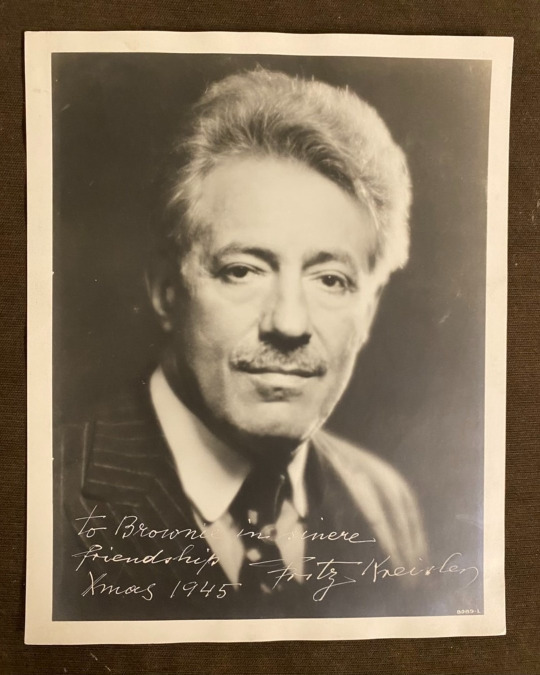

OTD in Music History: Legendary violin virtuoso Friedrich "Fritz" Kreisler (1875 - 1962) makes his American debut at Steinway Hall in New York City in 1888, kicking off his 1st American tour (1888–1889) with famed concert pianist Moritz Rosenthal (1862 - 1946).
A remarkable child prodigy, Kreisler first studied music at the Vienna Conservatory from 1882-1885 (where his teachers included Anton Bruckner [1824 – 1896]) before moving on to the Paris Conservatory from 1885-1887 (where his teachers included Léo Delibes [1836 - 1891] and Jules Massenet [1842 – 1912]).
When Kreisler graduated from the Paris Conservatory at the tender age of 12, he was awarded a prestigious gold medal -- beating out 40 other violinists (all of whom were at least 20 years old) to secure that honor.
Kreisler was also a noted composer who wrote a number of enduringly popular short pieces for the violin.
Some of these compositions were pastiches, ostensibly penned in the style of other composers -- and indeed, Kreisler originally "passed them off" as the work of famous Baroque composers including Giuseppe Tartini (1692 - 1770) and Antonio Vivaldi (1678 - 1741).
When Kreisler finally came clean about this deception in 1935, a number of prominent music critics who had been completely taken in by this ruse raised a fuss in the press.
Kreisler, however, took great pleasure in wryly pointing out that whatever their qualms, the critics themselves had already conceded the high quality of the music itself: "The name printed on the sheet music may now change, but the musical value of the underlying notes remains very much the same!”
PICTURED: A publicity headshot showing the elderly Kreisler, which he signed and inscribed to a friend with "Xmas" wishes in 1945.
Today: Watch the only known (unfortunately silent) film footage of legendary violin virtuoso and composer Fritz Kreisler (1875 – 1962) playing his violin, which was shot at the house of a family friend c. 1930.
It is actually rather surprising that we don’t have *more* film footage of Kreisler in action (including sound footage), considering that he lived into the 1960s. The most likely explanation comes from the fact that Kreisler was involved in a serious traffic accident in 1941, which put him in a coma for a week and largely derailed his later career. This unfortunate incident probably robbed of us many additional opportunities for film footage with sound to be shot...
According to one eagle-eyed observed, Kreisler appears to be playing part of the “Sarabande” from J.S. Bach’s (1685 – 1750) 1st Violin Partita (BWV 1002).
#classical music#music history#composer#classical composer#classical studies#maestro#Fritz Kreisler#Kreisler#violin#violinist#virtuoso#Concerto#Concert#classical musician#classical musicians#classical history#history of music#historian of music#musician#musicians#music education#music theory#cadenza#Steinway Hall#Philharmonic
13 notes
·
View notes
Video
n27_w1150 by Biodiversity Heritage Library
Via Flickr:
Reichenbachia :. St. Albans [England] :N.Y. [i.e. New York] :F. Sander ;R.B. Young,1892-1894.. biodiversitylibrary.org/page/35543476
#(Heinrich Gustav)#1824-1889#Orchidaceae#Reichenbach#H. G#Missouri Botanical Garden#Peter H. Raven Library#bhl:page=35543476#dc:identifier=http://biodiversitylibrary.org/page/35543476#author:name=Henry Frederick Conrad Sander#orchids#botany#flowers#taxonomy:family=Orchidaceae#artist:name=Henry George Moon#artist:viaf=95737474#taxonomy:binomial=Dendrobium phalaenopsis var. statterianum#taxonomy:binomial=Dendrobium bigibbum#flickr#Phalaenopsis#dendrobium phalaenopsis#cooktown orchid
0 notes
Text
The Man with the Twisted Lip
There were probably a couple of opium dens in London, but they were far common in France or the western United States.
London Bridge was the easternmost fixed crossing a vehicle could use in 1889. Tower Bridge was under construction and the Thames Tunnel was used by trains by this point. The latter still is, part of the London Overground. So, it was ferries east of that.
The wharves and docks stretched (mostly) on the north of the river east of London Bridge to Beckton. There were some smaller older quays to the west, like the now Hays Galleria shopping area. The docks at Tilbury also existed and they would take over as ships got bigger, leading to the gradual closure of the old docks, deprivation and then gentrification.
London's Chinatown consisted of less than a thousand residents and was in Limehouse. It is now in Soho, an area that was historically a red-light district but is mostly gentrified now, with a somewhat larger population due to immigration from Hong Kong.
The East End had a reputation as "a wretched hive of scum and villainy" fuelled by stories like this (also the Ripper murders of 1888), but was mainly just very poor. Slum clearance efforts were beginning, but not in any coordinated or effective manner at this point.
Threadneedle Street, in the City of London, is best known as the location of the Bank of England.
Lee was a middle-class suburb that sat on the edge of London in 1889; it had just been taken from Kent and incorporated into the new County of London. But suburban residents in London will still frequently identify with traditional counties.
However, the massive expansion of the city in the first half of the 20th century put Lee in inner London and it today sits in Zone 3 for public transport fares. Indeed, the opening of the railway station in 1866 is what made Lee a desirable area and it still is.
Bow Street police station was a famous police station in London, sharing the building with an equally famous magistrate's court - the building was pretty new, finished in 1881, but the Bow Street Runners before that (set up in 1749 by judge and author of Tom Jones Henry Fielding) were the first effective law enforcement force in London. The former closed in 1992, the latter in 2006 and there is now a museum on site.
"Hugh Boone" would have been charged and fined for breaking the Vagrancy Act of 1824, a piece of Georgian-era legislation enacted because the British government decided that the best way to deal with a surge in poverty and homelessness after the Napoleonic Wars, along with a massive internal influx of economic migrants, was to make rough sleeping and begging illegal, with a maximum sentence of a month's hard labour. This act also covered prostitution, but was in practice mostly used against gay men.
The act remains on the statute books, albeit heavily amended - and somtimes used against homeless people; with 114 people charged in Greater London in 2019-2020. The currently Tory government has pledged to repeal the act and passed legislation in 2022 that will allow for that once a replacement act is enacted to cover some of the other offences in the still-extant text, like hiring children as beggars.
34 notes
·
View notes
Photo

Samuel Baruch Halle (French, 1824-1889)
The first lesson, 1853
#samuel baruch#samuel baruch halle#art#fine art#french art#french#france#the first lesson#1800s#classical art#fine arts#the first lesson 1853#mother and child#motherhood#woman and child#woman#female portrait#women in art#female#portrait#1800s fashion
84 notes
·
View notes
Text
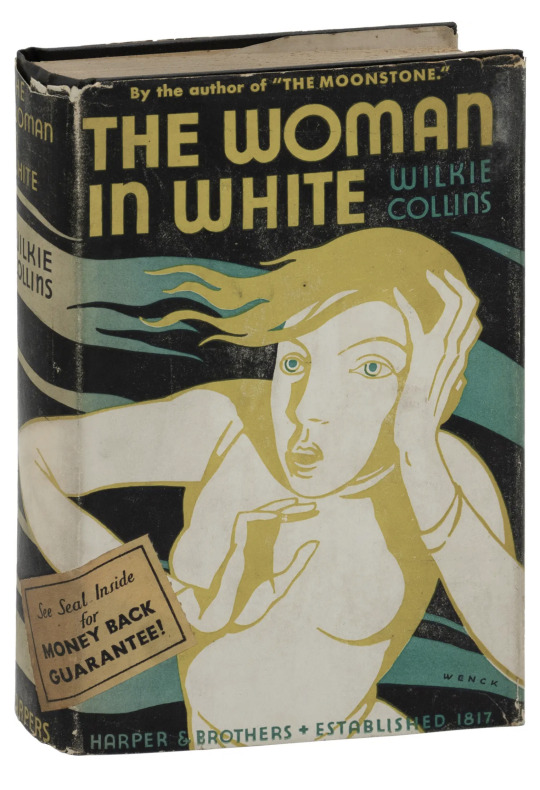

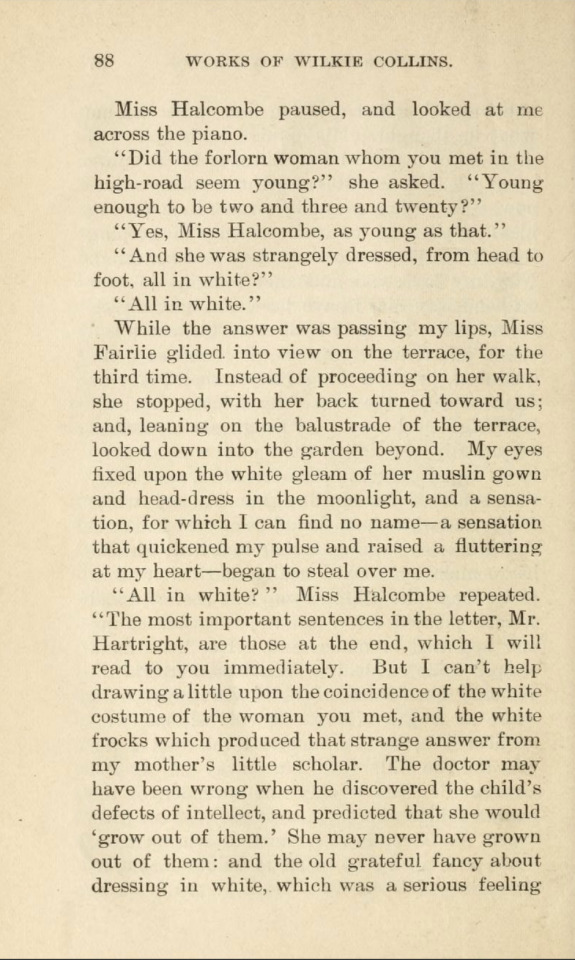
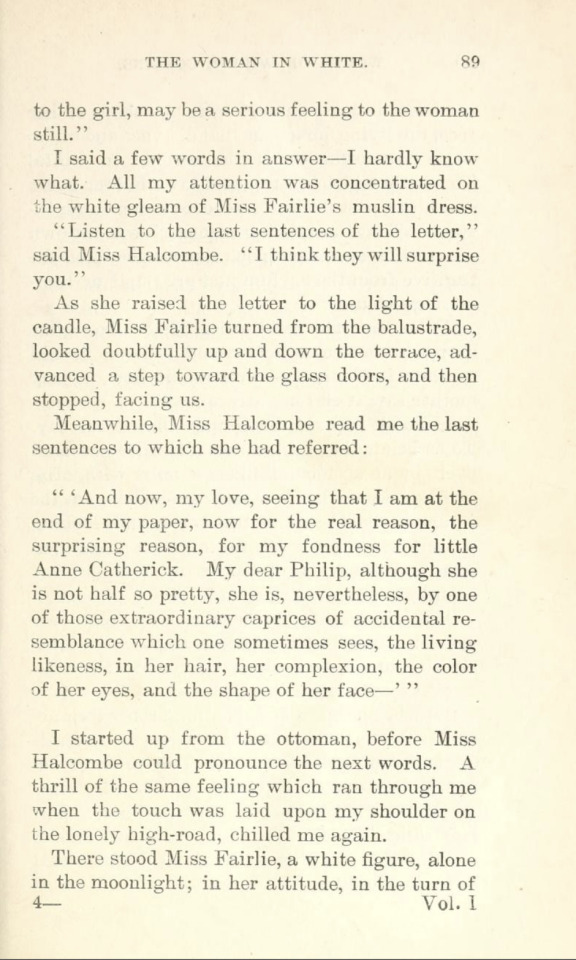
The Woman In White, a novel by Wilkie Collins (1824-1889). (New York: Harper and Brothers, 1932. First Edition.)
#novel#fiction#literature#British novel#British fiction#British literature#classics#mystery#gothic#horror#19th century#Victorian#historical fiction#The Woman In White#Wilkie Collins#white clothing#white dress#white attire#dressed in white#clothed in white
6 notes
·
View notes
Text
Elizabeth Matilda Church Bunner (1783-1867)

Elizabeth was the second daughter of Angelica Schuyler Church and John Barker Church. Angelica had teased her sister, Elizabeth, about the name, saying that she was going to name her second daughter Eliza after John Barker Church’s mother.
She married Rudolph Bunner (1779-1837) and had at least three children, including Catherine Cruger Bunner, as though that’s not confusing since Elizabeth’s older sister was Catharine Church Cruger (1779-1839).* But before you assume that Elizabeth was naming her own daughter after her sister, Bunner was also a Cruger going back a couple generations on his mother’s side. If the name Cruger seems familiar, it’s because one of AH’s boss on St. Croix was Nicholas Cruger (1743-1800). Nicholas was Catharine Church Cruger’s father-in-law; in 1802 she married his son, Bertram Peter Cruger, born on St. Croix in 1772. Read all about the 18th century Cruger men.
But back to the Angelica-John Barker Church children.

From the top, clockwise, the four paintings are Elizabeth Matilda Church (1783-1867), John Barker Church, Jr. (1781-1865), Catharine “Kitty” Church (1779-1839), and Philip Church (1778-1861) painted by John Trossarelli.
See this summary of the Church kids by Danielle Funiciello. Not painted are Richard Hamilton Church (1785-1786), Alexander Church (1792-1802), and Richard Stephen Church (1798-1889).
By the way, John Church Cruger (1807-1879), son of Catharine Church Cruger, eventually marries (1843!) Euphemia White Van Rensselaer, one of the daughters of Stephen Van Rensselaer III (whose first wife was Margarita/Peggy Schuyler) and his second wife. And they give their kids names like Catherine Church Cruger and Stephen Van Rensselaer Cruger.
Stephen Van Rensselaer IV (1789-1868), the only child of Peggy’s who survived into adulthood, married Harriet Elizabeth Bayard (1799-1875), William Bayard’s daughter. To confuse one further, they had children with names like Margaret Schuyler Van Rensselaer (1819-1897) and Catherine Van Rensselaer (1827-1909), in addition to the obvious Stephen Van Rensselaer (1824-1861).
*In one of his letters, AH mentions that he knew Catharine from the time Angelica was pregnant with her, which means AH had met Angelica by 1779 at least. I’ve always thought a good argument could be made that he may have first met several of the Philip and Catharine VR Schuyler kids in 1774, by the time of the wedding of John Jay and Sarah Livington, daughter of William Livingston whom AH may have stayed with during this period. Livingston was related to both Philip Schuyler and Catharine VR Schuyler.
13 notes
·
View notes
Text

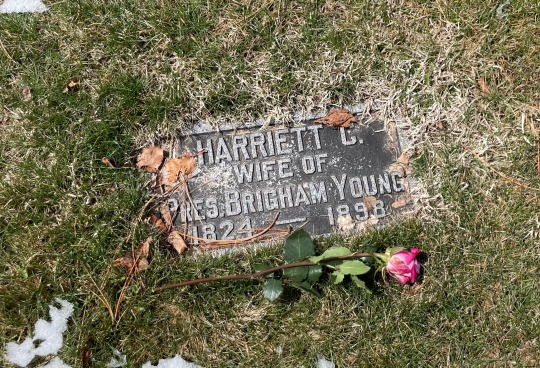

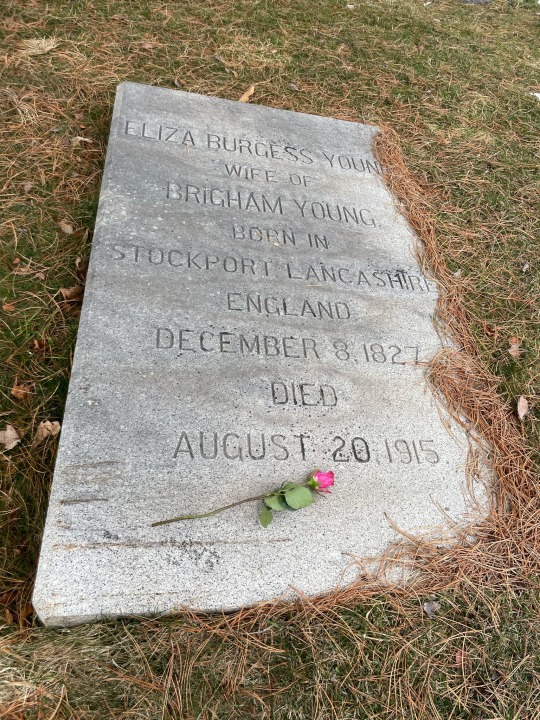
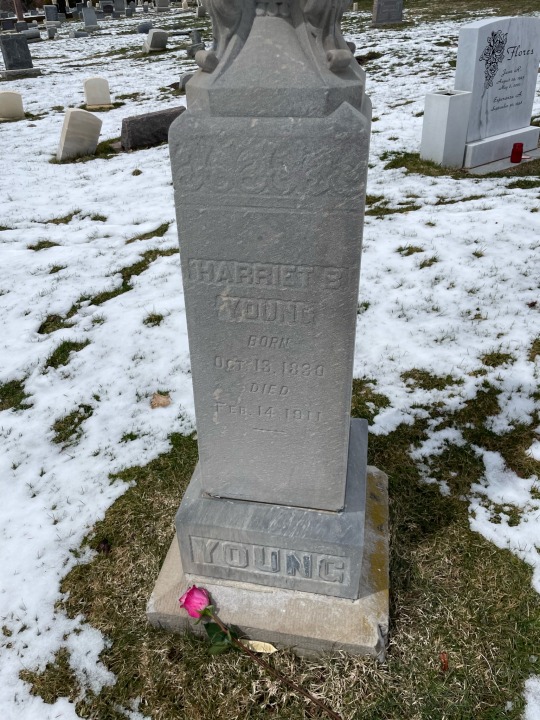

I mentioned earlier that a lot of Young family members are scattered around the Salt Lake City cemetery in a few different sections, so I thought I'd share the graves for some of the women I don't know as much about in a post together. Aside from Emily Partridge and Zina Huntington, who I'll make a separate post for in a bit, these are all the wives of Brigham Young I located in the SLC cemetery (ie, not buried with him in the family graveyard). I put the pictures of both the graves and the women in chronological order of when they married into the family, which also (roughly) tracks with their age.
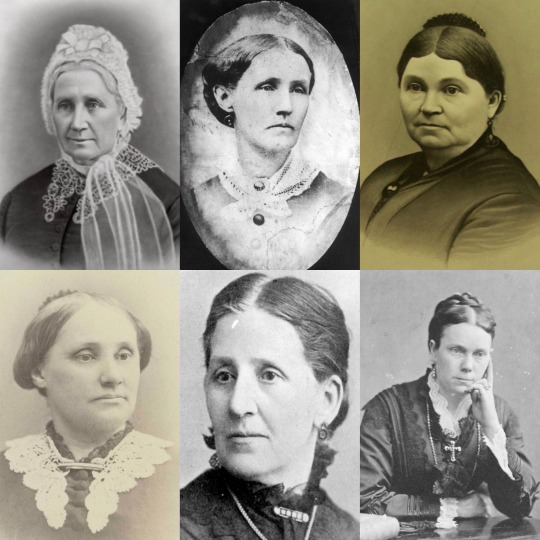
Augusta Adams Cobb (1802-1886) lived in Boston with her first husband and nine children before being converted to Mormonism by Brigham Young when he was a missionary in Massachusetts. She ended up leaving her first husband and her older children to move to Nauvoo with her two youngest and become Brigham's second plural wife. They were about the same age and she did not have children with him. The marriage proved rather fraught, as she wrote him numerous letters complaining with quite caustic language about him paying more attention to younger wives. They did stay married, although he eventually agreed to allow her to unseal from him and seal herself to Joseph Smith for eternity. Twenty-five years later, her son James's ex-wife Mary van Cott ended up becoming Brigham's second-to-last wife. When Augusta died, she was initially buried according to her wishes with Brigham, but her daughter Charlotte, who had left Mormonism as an adult, later had her exhumed and she is now buried with James, Charlotte, and Charlotte's husband. You'll note that Augusta's current gravestone does not mention Brigham Young at all--I'm assuming that was probably Charlotte's choice as well.
Harriet Cook (1824-1898) (identified on her grave as Harriett C.) was Brigham Young's third plural wife and the last woman he married before Joseph Smith's death. I don't know a lot about her except that virtually every reference I've found to her involves other women talking about her being difficult to get along with and irritable, though there's also references to her being brave and intelligent. Apparently, she told a sister-wife that she was "only a proxy wife" and Brigham didn't love her. I don't get the sense that she was a particular favorite either, so I tend to interpret her behavior as someone who was unhappy with her situation trying to "punch down" on wives she viewed as being worse off than her. She had one son, Oscar, who she is buried next to.
Clara Decker (1828-1889) was the younger sister of Lucy Decker, Brigham's first plural wife. She married him in 1844 when she was fifteen. I don't know a lot about her life or personality, unfortunately. Her obituary refers to her as "of a very modest and retiring disposition". Clara, like many other women whose life was primarily in the sphere of the home and who did not leave much if any personal writing, is hard to find traces of in the historical record. (Very much women's historian and fellow Mormon Laurel Thatcher Ulrich’s "well-behaved women rarely make history"). As her gravestone and much of the contemporary writing I can find about her tells us, she was one of three women who accompanied the vanguard pioneers into the Salt Lake Valley in 1847. The other two women were wives of Heber Kimball and Brigham's brother Lorenzo Young. Again, we don't know what Clara thought or felt about this journey, but I imagine traveling to an unknown new home as a nineteen-year-old in a company of over 140 men led by her husband must have been a bit of a strange experience. She is buried next to her daughter Jeanette and near her two other daughters. She also had two sons who did not live to adulthood.
Eliza Burgess (1827-1915), unfortunately, I do not know a lot about either. Eliza immigrated from England to Nauvoo with her family and worked in the Lion House as a servant before marrying Brigham at age 25. Her stepdaughter Susa Young, who wrote a fair amount about her childhood in the Lion House and is one of the only sources on the personality of some lesser-documented wives, described her as a "capable, efficient housewife" and said that "her one release from what might have been corroding jealousy in a lesser soul was driving labor", which is frankly pretty depressing. Susa also described Eliza as a doting mother to her only child, Alfales. As an adult, Alfales was editor of a Mormon-critical paper and was one of two children of Brigham Young who I know outright left the church. Eliza lived with him after being widowed until her death, and he is buried next to her. She was Brigham Young's last surviving wife. Interestingly, there's a photograph taken of Brigham's other seven living wives in 1899, but for some reason Eliza was not included (maybe because of her son's outspoken religious views?)
Harriet Barney (1830-1911) first married at the age of sixteen as the third wife of 31-year-old William Sayers, though their first child was not born until about five years later. She left Sayers after four children and remarried Brigham Young in 1856. (Though both her marriages were polygamous, single mothers, whether divorced or widowed, were disproportionately likely to be in plural marriages if they married again.) She had one more child, Phineas Young, who she is buried next to. Susa Young described her as a "calm, peaceful soul" who was friendly with her sister-wives even though she did not live in the Lion House, which was already fully occupied by the time she married into the family. Her obituary implies that she had suffered from some sort of chronic illness for 40 years by the time of her death.
Finally, we have the third woman named Harriet that Brigham Young married, generally known to historians as Amelia Folsom--she started going by her middle name after her marriage to distinguish herself from the two other Harriets. Harriet Amelia (1838-1910) married 61-year-old Brigham in 1863, and was his undisputed favorite wife until his death. She was the oldest child of church-employed architect William Folsom, apparently a talented pianist and singer, described by contemporaries as charming and fashionable, and frequently accompanied her husband to dances and the theater. As he aged and developed various health problems, she also provided him comfort and companionship at home, including at his home in southern Utah, where he spent the last several winters of his life with just Amelia. She seems to have been liked by some of her sister-wives and resented by others. She never had children--I'm guessing she was not able to, because he had children with other women after their marriage. Still in her thirties when she was widowed, she was left a significant bequest. She ended up spending some time living with her elderly father as his caregiver (like her husband, he suffered from arthritis), and then purchased her own home, where she taught piano lessons and entertained until being disabled by a stroke three years before her death.
The only one of these women who left much of anything in her own words was Augusta, so there's definitely a process here of guesswork when you try to reassemble what these women and their lives might be like, working off the reminiscences of co-wives, stepchildren, children, and public memory.
#i'm intrigued by the placement of Amelia's grave bc she evidently chose not to be buried with brigham but she also didnt have kids to be#buried with and she's not near her parents or siblings either#or sister wives she's sort of like...by herself.#again like i have no idea how she felt about her husband or if she was sad she didn't have kids or if she felt like she was living her best#life as a financially stable widow who owned her own home and taught piano. but she kind of makes me sad :(#i sought her out bc i wanted to give her a rose. everyone else in this post i sort of stumbled across while looking for emily partridge#Mormonposting tag#julia in utah 2023
7 notes
·
View notes
Text

Up the airy mountain
Down the rushy glen
We daren’t go a hunting
For fear of little men
Wee folk, good folk
Trooping all together
Green jacket, red cap
And white owls feather
By the craggy hillside
Through the Mosses bare
They have planted thorn trees
For pleasure here and there
Is any man so daring
As dig up them in spite
He shall find their sharpest thorns
In his bed at night
Up the airy mountain
Down the rushy glen
We daren’t go a hunting
For fear of little men
Wee folk, good folk
Trooping all together
Green jacket, red cap
And white owls feather
The faeries🍃
By William Allingham 1824 - 1889
Art by Arthur Rackham
🍃William Allingham is a well known Irish poet and writer. And his endearing rhyme about the faery folk shall forever be. Why, I do believe he really knew of the fair folk🍃
Tales of the old Forest Faeries
3 notes
·
View notes

